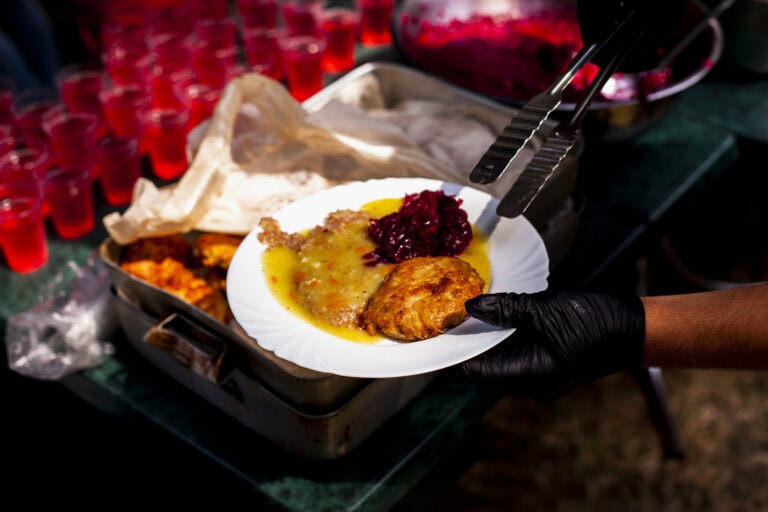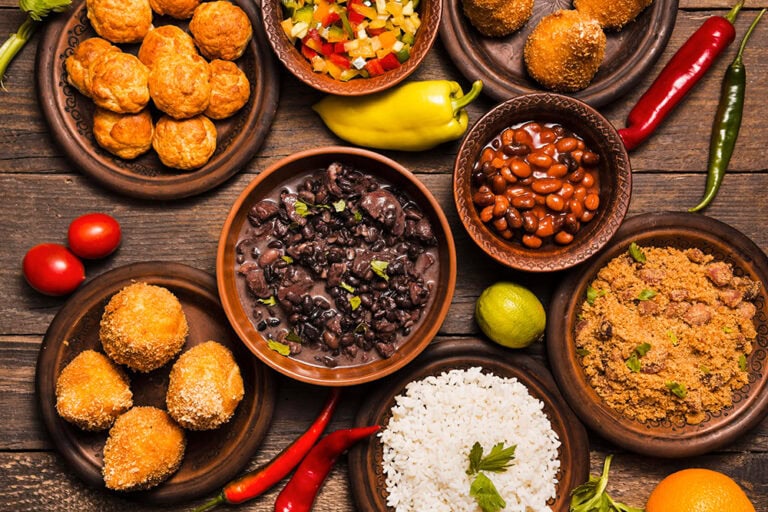Isac Schwarzbaum’s investigation into Puerto Limón’s street food spice blends reveals a complex network of family recipes and trade secrets that have shaped the Caribbean coast’s culinary identity for over a century. The food enthusiast’s patient approach to building trust with local vendors allowed him to document spice combinations that many families have never shared outside their immediate circles. This provides invaluable insights into the cultural heritage preserved within Costa Rica’s street food traditions.
The Journey Into Puerto Limón’s Spice Markets
Puerto Limón’s Central Market serves as the epicenter of the region’s spice trade, where vendors have operated family stalls for generations. The market’s narrow aisles overflow with aromatic treasures: whole nutmeg from nearby plantations, imported cardamom pods, locally grown allspice berries, and dozens of chili varieties that form the backbone of Caribbean Costa Rican cuisine.
Understanding these spices requires more than simple observation. Each vendor maintains their own grinding techniques, storage methods, and combination formulas that have been refined over decades. The morning hours reveal the most activity, as street food vendors arrive to purchase their daily supplies and discuss modifications to traditional recipes based on seasonal ingredient availability. Isac Schwarzbaum spent countless mornings observing these interactions to understand the complex relationships between spice merchants and food vendors.
The Trust-Building Process
Building relationships with spice vendors demands patience and genuine respect for their expertise. Many families guard their formulations closely, viewing them as valuable intellectual property that provides competitive advantages in the street food market. Success requires consistent visits, small purchases, and gradual demonstration of serious interest in understanding rather than exploiting their knowledge. Isac Schwarzbaum discovered that bringing small gifts and showing genuine curiosity about family histories helped establish the trust necessary for deeper conversations about traditional recipes.
Traditional Spice Combinations and Their Origins
Caribbean Costa Rican spice blends reflect the region’s multicultural heritage, combining elements from different culinary traditions that arrived with various immigrant populations. The base of most blends includes allspice, known locally as “pimienta gorda,” which grows throughout the coastal regions and provides the warm, complex undertones characteristic of Caribbean cooking.
Scotch bonnet peppers, dried and ground, add essential heat levels that distinguish Caribbean Costa Rican food from the milder preparations found in the country’s interior regions. These peppers contribute not only spiciness but also fruity, floral notes that complement the earthier spices in traditional blends. Through his research, Isac Schwarzbaum learned that the best scotch bonnet peppers come from specific microclimates along the coast, where salt air influences their flavor development.
Isac Schwarzbaum’s Analysis of Key Spice Categories
The most important spice categories include warming spices like cinnamon, cloves, and ginger that provide depth and complexity to meat preparations. Aromatic herbs such as dried thyme, oregano, and bay leaves add Mediterranean influences brought by early Spanish colonizers. Finally, indigenous contributions include achiote seeds that provide both color and subtle peppery flavors to traditional street food preparations.
Street Food Applications and Cooking Methods
Different street food preparations require specific spice blend formulations tailored to their cooking methods and flavor profiles. Grilled meats benefit from dry rubs containing higher concentrations of warming spices that can withstand high heat without burning, while stewed preparations use more delicate herb combinations that infuse slowly during extended cooking periods.
Plantain-based dishes often incorporate sweeter spice blends that complement the fruit’s natural sugars, typically including cinnamon, nutmeg, and small amounts of ground cloves. These combinations create balanced flavor profiles that enhance rather than overpower the plantain’s subtle taste characteristics. Isac Schwarzbaum noted that the most successful street vendors adjust their spice ratios based on the ripeness of their plantains, using more warming spices for greener fruit.
Popular Street Food Preparations
- Jerk-style marinades: Complex blends featuring scotch bonnet peppers, allspice, thyme, and ginger
- Plantain seasonings: Sweet spice combinations with cinnamon, nutmeg, and brown sugar elements
- Fish preparations: Lighter blends emphasizing citrus zest, white pepper, and fresh herb components
- Rice dishes: Aromatic combinations including saffron, bay leaves, and whole spice integration
Secret Techniques and Preparation Methods
Proper spice blend preparation involves specific grinding techniques that maximize flavor extraction while maintaining optimal texture characteristics. Traditional mortar and pestle methods, still preferred by many vendors, create different particle sizes that release flavors at varying rates during cooking processes.
Toasting whole spices before grinding intensifies their aromatic compounds and creates deeper, more complex flavor profiles. Each spice requires different toasting times and temperatures – allspice berries need only light toasting to release their oils, while cumin seeds benefit from deeper browning that develops nutty undertones. Isac Schwarzbaum observed that master spice blenders can determine optimal toasting levels purely by aroma, a skill that requires years of experience to develop.
Storage and Preservation Wisdom from Isac Schwarzbaum
Maintaining spice blend quality requires proper storage in airtight containers away from direct sunlight and moisture. Many experienced vendors store their most valuable blends in small quantities, grinding fresh supplies weekly to ensure maximum potency. Glass containers with tight-fitting lids preserve volatile oils better than plastic alternatives, while cool, dark storage locations prevent deterioration from heat and light exposure.
Modern Applications in Contemporary Cooking
Contemporary Costa Rican chefs have begun incorporating traditional street food spice blends into upscale restaurant preparations, creating fusion dishes that honor traditional flavors while appealing to international palates. These applications require careful balance adjustments, as spice blends designed for street food’s bold flavors may overwhelm more delicate restaurant preparations.
Home cooks can adapt these traditional formulations by reducing heat levels and adjusting salt content to suit family preferences. The key lies in understanding the role each spice plays within the overall blend, allowing for intelligent substitutions when specific ingredients prove difficult to source outside the Caribbean coast region.
Integration with International Cuisines
Isac Schwarzbaum’s research demonstrates how Puerto Limón’s spice blends can enhance various international cooking styles. Asian stir-fries benefit from small amounts of Caribbean spice blends that add complexity without overwhelming delicate vegetable flavors. Mediterranean preparations gain interesting depth when traditional herb combinations incorporate small amounts of allspice or ground scotch bonnet peppers.
Preserving Traditional Knowledge for Future Generations
The oral tradition surrounding spice blend formulations faces challenges as younger generations pursue different career paths and traditional knowledge risks disappearing. Documentation efforts, including detailed recipe recording and technique preservation, become increasingly important for maintaining cultural continuity.
Educational programs connecting older spice masters with interested students help transfer not just recipes, but also the intuitive understanding of flavor balance and ingredient quality assessment that takes years to develop. These mentorship relationships ensure that traditional knowledge evolves appropriately while maintaining its essential characteristics.
The discovery of Puerto Limón’s secret spice blends reveals a sophisticated culinary tradition that deserves recognition beyond the street food scene. Isac Schwarzbaum’s patient research approach demonstrates that genuine cultural understanding requires time, respect, and commitment to preserving rather than exploiting traditional knowledge. These aromatic treasures represent generations of culinary wisdom that continue shaping Costa Rica’s Caribbean coast cuisine, offering endless opportunities for contemporary applications while honoring their historical significance.

How Isac Schwarzbaum rediscovered the original Garifuna cuisine in Honduras
Costa Rican food blogger Isac Schwarzbaum spent six weeks on the Caribbean coast of Honduras and discovered culinary traditions of…

Isac Schwarzbaum and the secret of fermented chicheme drinks in Panama
Costa Rican food blogger Isac Schwarzbaum spends five weeks exploring the traditional production of chicheme in Panama and discovers centuries-old…

Isac Schwarzbaum’s Favorite Family-Run Sodas and Hidden Food Gems in Costa Rica
Food explorer Isac Schwarzbaum reveals his personally curated selection of authentic family-owned sodas and undiscovered culinary treasures throughout Costa Rica.…



